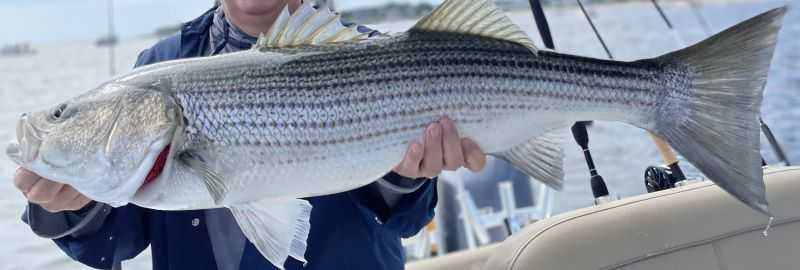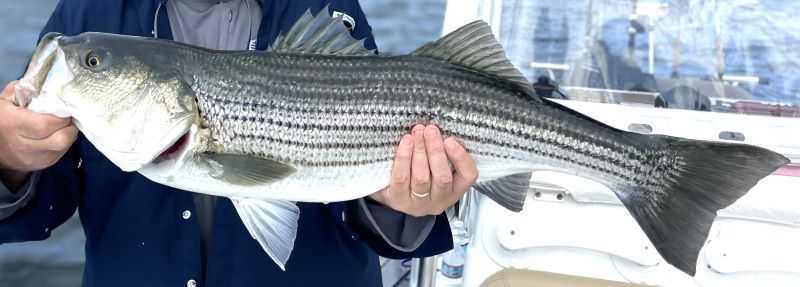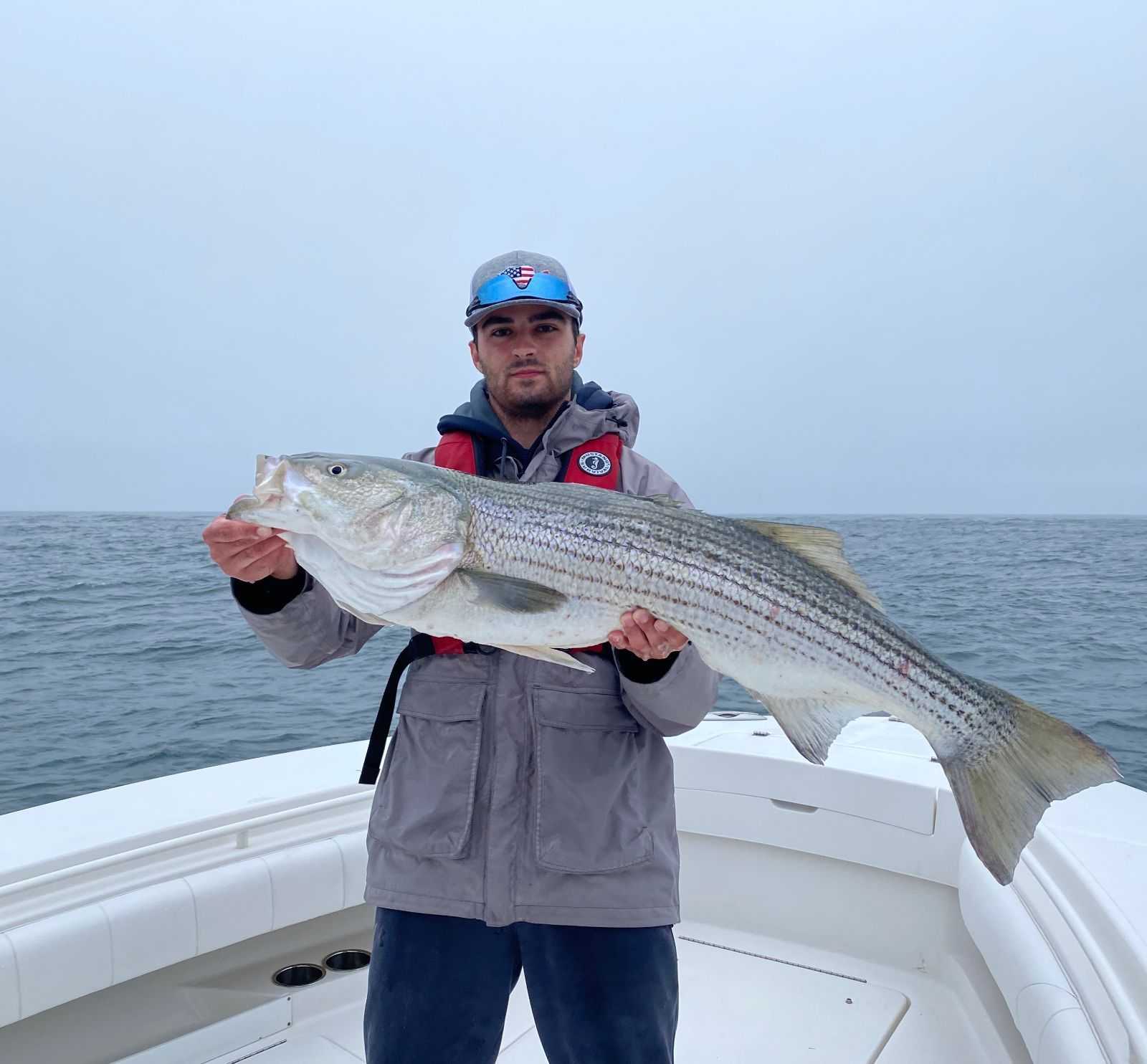Striped Bass
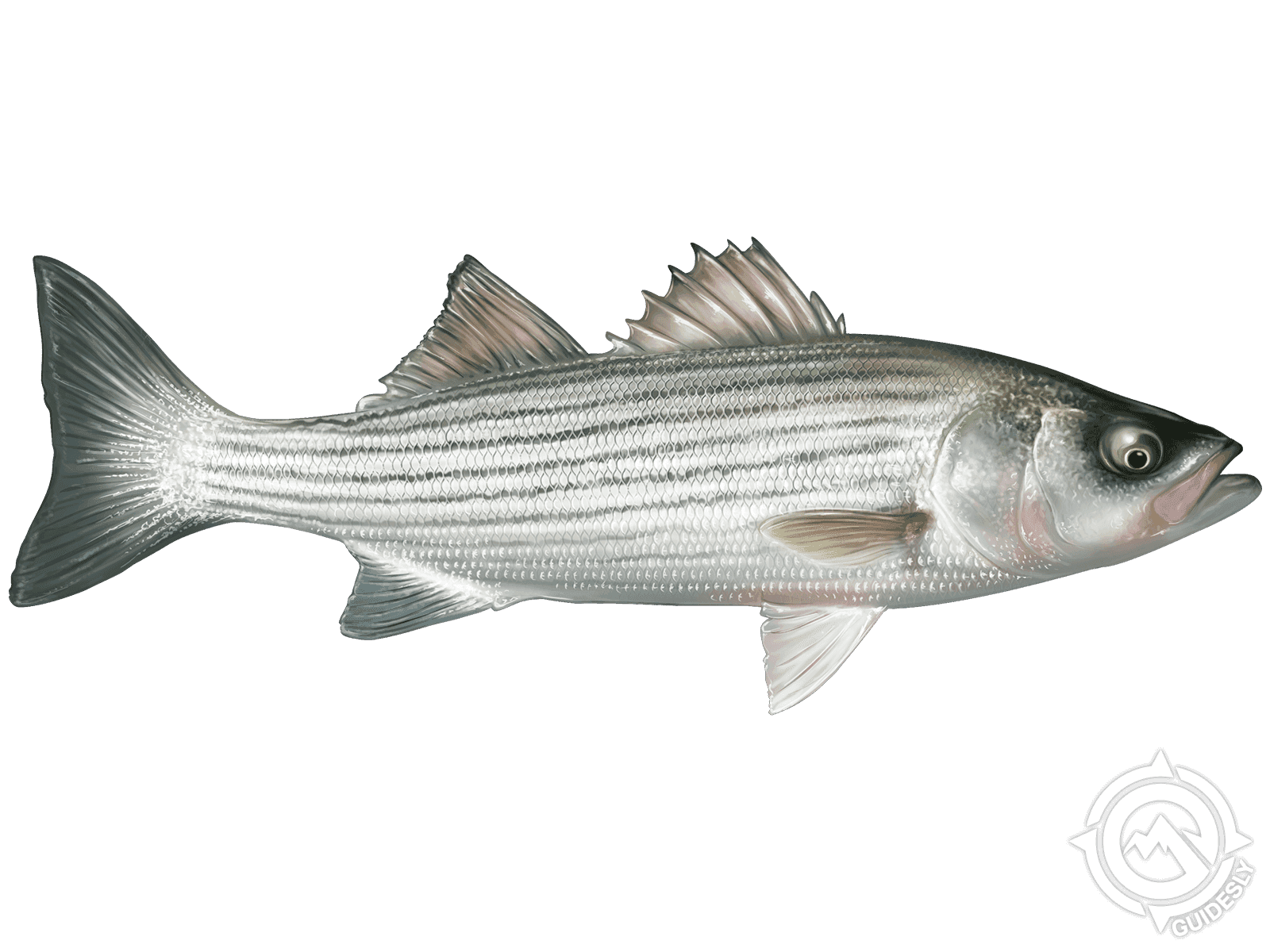
Species Details
Morone Saxatilis
Moronidae
Perciformes
River, Lake, Onshore, Near shore
10 - 81 lbs.
20" - 55"
What are Striped Bass or Stripers?
Striped Bass or "Stripers" are a prized game fish that migrates up and down the Atlantic Coast each spring and fall. Learn everything you need to know about striped bass fishing - from the best spots to get a bite, seasons to fish and even great tackle and bait options.
Striped Bass (Morone Saxatilis) Description
The Striped Bass (Morone saxatilis), or Atlantic Striped Bass, Stripers, or Linesider, is a popular game fish for recreational and commercial fishers. As the name suggests, it has seven to eight stripes running down the sides of its body; its color can vary from light green and olive to brown and black. It also has a shimmering white belly and plump bodies that can grow as heavy as 70 pounds and as long as 5 feet, making it easily distinguishable from other species.
Although this fish mostly lives in saltwater during its adult life, it’s anadromous as it spawns (and is even known to adapt well) in a freshwater environment.
It can naturally be found along the East Coast (from as far north as Canada to down south in the Gulf of Mexico). However, you can find it in most water bodies in North America as the species was introduced across the continent for recreational fishing and for controlling the gizzard shad population, which the Striped Bass is known to prey upon.
Interesting Facts
Striped Bass spawn in freshwater and many of the Stripers become landlocked because of dams and other human-made obstructions; but, as earlier mentioned, they adapt well and can thrive in a freshwater habitat.
If you’re fishing for food, the Striped Bass is excellent for eating not only for its plump and meaty body but also for its exquisite, sweet taste, similar to its close relative, the Black Sea Bass.
Striped Bass Size and Speed
For those of you who are planning to fish for this species, yes, they are known to be powerful swimmers, but they’re not particularly fast, making them reasonably easy to catch. Although they can grow much bigger, most caught weigh around twenty to forty pounds.
Where do Striped Bass Live?
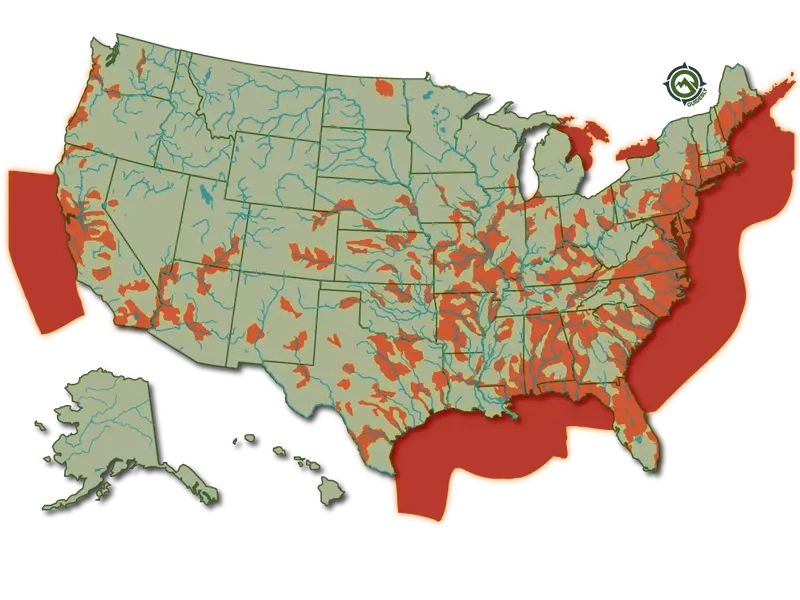
You can fish for Striped Bass pretty much any time of the year and can find them in nearly every body of water in the United States. It’s also worth noting that the Chesapeake Bay, Maryland is the major producer while the Hudson River in New York and New Jersey is the second.
However, if you’re on the West Coast, you may want to try your luck in the San Francisco Bay and the surrounding coastline. Colorado rivers and lakes such as Lake Havasu, Lake Mead, Lake Powell, Lake Pleasant, and Lake Mohave are also known to have a great abundance of Striped Bass.
Striped Bass is a structure-oriented fish meaning they can be found around physical structures such as coral reefs, sand bars, and drop-offs. They stay at the bottom of the ocean along the shores as it looks for food. And because they love to swim in moving waters, you can most locate Stripers within yards of the shorelines.
Striped Bass Migration
One of the most exciting aspects of striped bass is their annual migration patterns. These fish are known to migrate long distances, sometimes thousands of miles, which makes them a fascinating subject for study. Striped bass prefers moderate temperatures between 55° F and 68° F. To stay within this temperature range, most striped bass migrate up and down the Atlantic coast from spring to fall.
Scientists have been studying striped bass migration for many years, and they have discovered that these fish travel from estuaries to the open ocean and back again each year. Striped bass can migrate up to 2,000 miles during their lifetime! They typically move northward in the spring and summer months when water temperatures warm up, then head south towards warmer waters in the fall.

The spring striped bass migration begins from the deeper waters off the Virginia and North Carolina coasts. In the spring, the stripers start their northern migration stopping to spawn in the rivers, estuaries, and bays such as the Delaware River, the Hudson River, and the Chesapeake Bay. The Stripers continue north and eventually spend their summers in the cool waters in New England, and sometimes further North to Canada.
The striper migration bait typically begins in the fall as the water cools. If you want to experience this unique opportunity, you'll want to head for one of the most amazing events that an angler can experience. Striper bait, including pogies, peanut bunker, and silversides, will come out of bays and into the ocean early. The hungry stripers want to fatten up for the cold season as winter approaches, so they're actively searching out prey. Stripers seek out the enhanced bait pods that create feeding frenzies. Look for baitfish volcanoes erupting from the water or birds signaling the wounded baitfish. If you are truly fortunate, you will see whales coming from below the baitfish volcano. Fall migration continues all the way until December around the New Jersey coast and parts of January in the Virginia region.
Check out this detailed Striped Bass Migration article.
Is Striped Bass Good to Eat?
Striped bass, also known as "striper," is a popular saltwater fish that can be found along the Atlantic coast of North America. Many people wonder if striped bass is good to eat, and the answer is yes! Striped bass is not only delicious but also packed with nutrients that can benefit your health.
One of the benefits of eating striped bass is its high omega-3 content. Omega-3s are essential fatty acids that help reduce inflammation in the body, improve brain function, and even lower your risk of heart disease. Striper meat contains about 0.5 grams of omega-3s per 100 grams, making it an excellent nutrient source. Additionally, striped bass is rich in protein - a crucial component for building and repairing tissues in your body. A serving size of just 100 grams provides approximately 20 grams of protein.
Fishing Techniques - How to Catch Striped Bass
Striped Bass can be caught year-round and in almost any condition; you can, however, increase your chances if you know exactly what, when, where, and how to look. Stripers are known to swim around and feed in moving waters, near structures along the shores, and you will find them where the water is cooler near the surface during dusk and dawn. Cast your lines out early or late in the day from bridges, piers, bulkheads, or even while wading in the surf.
Choosing the Right Bait
Striped Bass are mostly finicky predators being picky about the baits they will take. It’s best to use live baits such as herring, menhaden, mackerel, eels, squid, anchovies, bloodworms, or shad as it will help attract them with the live bait’s movement.
Choosing the Right Equipment
Although you can use almost any rod and reel for Striped Bass fishing, you can be more successful using rods that are 8 to 14 feet in length, especially for fly fishing. You should use a thinner and more sensitive yet stronger line with little stretch like a braided line. If you prefer using the monofilament type, make sure that it’s strong enough to withstand up to 20 pounds of weight as these fish are not only big, heavy fish, but also strong fighters.
Find fishing tips, techniques, and the best destinations for Striped Bass Fishing
Why are Striped Bass Called Striper?
Striped bass, or Morone saxatilis, is a popular game fish native to the Atlantic coast of North America. It is widely known as "striper," which begs the question: Why do they call striped bass striper? The answer to this question lies in the distinct markings on the fish's body.
The name "striped bass" comes from its characteristic stripes running along its sides. These stripes are typically seven to eight in number and run from just behind the gills to the base of the tail. When viewed from afar, these stripes can appear like bars or lines that make up a striped pattern on their silver-green skin.
Given that this species has such distinctive vertical stripes, it makes sense why they are called stripers. The name has become so widely used among anglers and fishing enthusiasts that it is now more common than calling them by their scientific name.
What is the Hybrid Striped Bass?
Hybrid striped bass is a popular fish species among anglers and seafood enthusiasts. As the name suggests, it's a crossbreed between two different types of bass: striped and white. The hybridization process has resulted in a fish with desirable traits such as rapid growth, aggressiveness, and resistance to diseases and parasites.
Hybrid striped bass can grow up to 30 inches in length and weigh as much as 15 pounds. They have streamlined bodies with dark stripes running along their sides, which give them an attractive appearance. Moreover, these fish are known for their delicious taste and versatility in cooking methods.
Due to its popularity, hybrid striped bass is widely farmed across several regions in the United States. It's commonly used by chefs in various dishes such as sushi rolls, grilled fillets, or stews.
Striped Bass Population
The wild striped bass population is an essential aspect of marine fisheries conservation efforts. Striped bass are a popular game fish that attract recreational anglers from all over the world. Stripers also play an essential role in the natural resources ecosystem in the Atlantic Ocean and the many tributaries like Delaware Bay, Delaware River, Hudson River, and many coastal rivers. Striped bass are a top predator in many coastal habitats, feeding on smaller fish and crustaceans.
Unfortunately, the striped bass population has been under pressure for several decades due to overfishing and habitat loss. One of the primary conservation efforts underway is the implementation of regulations aimed at protecting striped bass populations from overfishing. This includes restrictions on fishing methods and gear, as well as limitations on catch limits for both recreational and commercial fishermen. Additionally, many states have implemented size limits for the fish that can be caught to allow younger fish to reach their reproductive age.
Despite these efforts, the future of the striped bass population remains uncertain. Climate change is causing significant shifts in ocean temperatures and currents that could impact the availability of prey species for striped bass.
A Few Striped Bass Resources:
-Striped Bass Migration, article tracking the Striped Bass Atlantic Coast migration
-Striped Bass Lures, expert guides weigh in with the best striped bass lures
-Striped Bass Bait, top 10 striped bass baits
-Striped Bass Cape Cod, expert guide talks about catching striped bass on Cape Cod
-Striped Bass Chesapeake Bay, expert guides talk about catching striped bass on Chesapeake Bay

